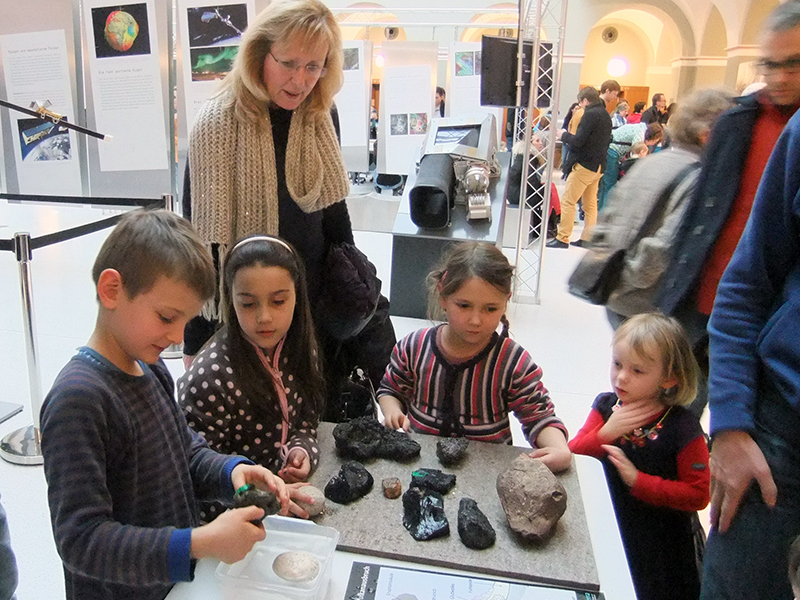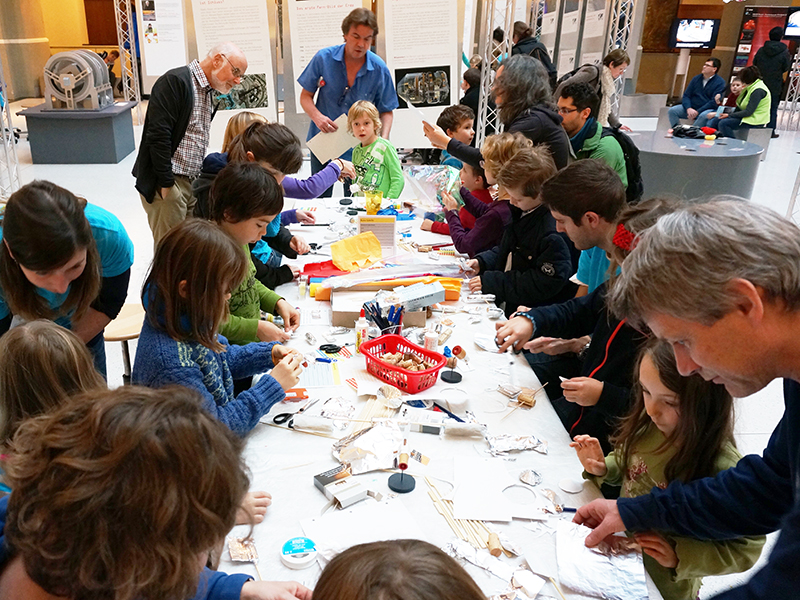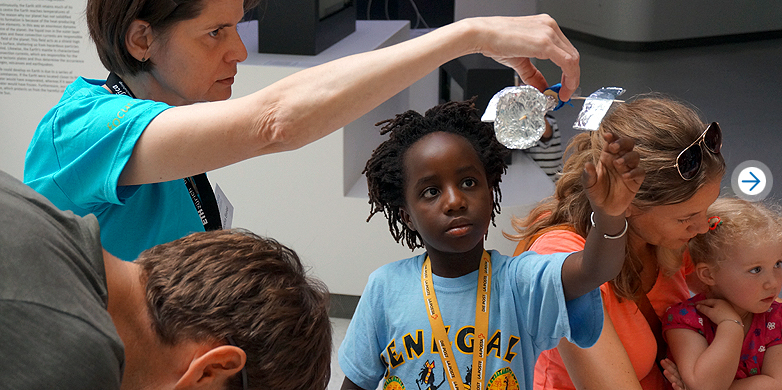Early practice makes perfect
Early childhood education in museums is standard nowadays. This has made museums an important place for creative out-of-school learning. How the ETH took part explains Columnist Ulrike Kastrup.
Tabea Schneider is bent intently over the solar panel. Is everything installed in the right place? Will it hold? Is the overall symmetry of the satellite correct? One last critical look … yes, it looks good. Satisfied, she leans back and looks up with her eyes alight.
All around her sit lots of little engineers who have just built their own satellite models. The table is strewn with craft supplies: aluminium foil, glue, colourful paper, pens, strings, adhesive foil, scissors, corks, cardboard and twigs.
At the next table, five- to eight-year olds are discovering weather phenomena such as hurricanes by generating their own storms inside plastic bottles. At another station, they can describe and weigh various stones in their hands to try and guess which ones will sink or float before trying it out in a basin of water. Others are trying to picture what the earth looks like from above and draw a landscape from bird’s-eye perspective. Even for the bigger kids, this task isn’t all that easy.
The children’s enthusiasm in discovering the earth and its mysteries at focusTerra is infectious. The focusTerra team and the numerous helpers, most of whom are students at the Department of Earth Sciences, show and explain things with the same joy and enthusiasm.
The museum, a place of learning
Early childhood education in natural science museums is standard nowadays. Museums offer attractive possibilities for family leisure activities. Besides schools, more and more day nurseries are also adding museum visits to their educational programmes. At museums, everyday experiences can be put into relation with scientific facts. This has made museums an important place for informal and creative out-of-school learning, which should be further strengthened through suitable, visitor-oriented educational services.
ETH Zurich is aware of the benefits of early childhood education. focusTerra, the Earth Science Research and Information Centre of ETH Zurich, is carried by the ETH Library and the Department of Earth Sciences. The very popular fairy tale Sundays are just one of the many events at ETH Zurich dedicated to the littlest of future scientists. In its “Experience Science” programme, Science City Junior offers children’s lectures as well as experiment and crafts workshops for children from the age of five. Scientifica also offers a large and popular children’s programme and kihz, the childcare organisation for Zurich’s universities, offers exciting and interactive insights into the world of research and teaching during school holidays.
Learning research at ETH Zurich
In order to foster pre-university learning and teaching, ETH also conducts research in the area of learning. The MINT learning centre (MINT = mathematics, informatics, natural sciences and technology) investigates and develops learning and teaching methods to give children a better approach to natural science subjects from primary school on. Here we can find, for example, an exercise complementing the experiment at focusTerra on “floating and sinking”. In this exercise, children get to know the fundamental concepts of buoyancy and density and learn to understand why a large ship made of steel floats while a small, massive piece of steel sinks. These exercises prepare children for later on in their educational careers when they will delve deeper into abstract topics of this kind.
But why does ETH Zurich make an effort in this area? Isn’t a university supposed to be just for studying and research?
Yes and no, because science doesn’t work without young researchers. And these have to be found and fostered. That is why it’s important to give children an exciting approach to natural science topics at an early age through stimulating games, experiments and teaching materials. Only then can their interest in these topics be fostered. For example, if children have lots of success experiences when doing experiments, then they will develop a long-term interest in such topics. There’s nothing like success to strengthen interest.
It is therefore worth giving children some well-structured background knowledge. Those who already learned in primary school that some materials are light for their size and that some are heavy for their size will have an easier time understanding the concept of density as a ratio of mass to volume in secondary school than others who do not have this knowledge. Practice makes perfect, and the earlier it starts, the better!
Next event
GIM – Generationen im Museum
More info
Picture Galerie
-

The experiment at focusTerra on "floating and sinking". In this exercise, children get to know the fundamental concepts of buoyancy and density. (Picture: ETH Zürich) -

Lots of little engineers who have just built their own satellite models out of aluminium foil, corks and cardboard. (Picture: ETH Zürich)
About the author
Ulrike Kastrup has been Director of focusTerra, ETH Zurich’s Earth Science Research and Information Centre, for five years. She studied geology at the University of Bonn and the University of Zurich and completed her doctorate at the Swiss Seismological Service in the Institute of Geophysics at ETH Zurich. She then went on to carry out research and work on risk management and risk communication in relation to natural hazards at various organisations and institutions, including the United Nations University in Bonn, Royal Melbourne Institute of Technology in Australia and as a Corporate Risk Manager at SBB (Swiss Federal Railways). By organising numerous exhibitions and activities at focusTerra, Ulrike Kastrup and her team are keen to open the public’s eyes to the beauty and fascinating qualities of geology as well as its role in everyday life.

